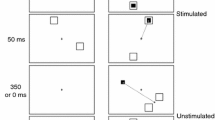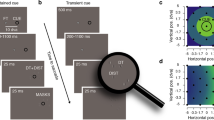Abstract
We examined the processes controlling selective orientation, specifically the processes required for generating saccadic eye movements in humans. Before a saccadic eye movement can be initiated, active visual fixation must be disengaged from the current point of fixation and a new target selected. We investigated whether these neural processes occur independently or interactively by devising a simple, multimodal choice reaction task in which subjects were asked to direct their gaze away from a central visual fixation target to an eccentric visual target while ignoring a simultaneous auditory distractor. Subjects had more difficulty suppressing incorrect movements toward the distractor when the fixation target was extinguished prior to onset of the eccentric target than when the fixation target remained illuminated during eccentric target presentation. Subjects with the shortest saccadic reaction times produced the most incorrect movements. These results support a recent hypothesis suggesting that the processes of disengaging active visual fixation and selecting a new saccade target are interrelated and arise, at least in part, from a change of activity within the superior colliculus.
Similar content being viewed by others
References
Fischer B (1987) The preparation of visually guided saccades. Rev Physiol Biochem Pharmacol 106: 1–35
Fischer B, Ramsperger E (1984) Human express saccades: extremely short reaction times in the monkey. Exp Brain Res 57: 191–195
Fischer B, Weber H (1993) Express saccades and visual attention. Behav Brain Sci 16: 553–610
Glimcher PW, Sparks DL (1992) Movement selection in advance of action in the superior colliculus. Nature 355: 542–545
Guitton D, Munoz DP (1991) Control of orienting gaze shifts by the tectoreticulospinal system in the head-free cat. I. Identification, localization, and effects of behavior on sensory responses. J Neurophysiol 66: 1605–1623
Hirsch JA, Chan JCK, Yin TCT (1985) Responses of neurons in the cat's superior colliculus to acoustic stimuli. I. Monaural and binaural response properties. J Neurophysiol 53: 726–745
Jay MF, Sparks DL (1987) Sensorimotor integration in the primate superior colliculus. I. Motor convergence. J Neurophysiol 57: 22–34
Kalesnykas RP, Hallett PE (1987) The differentiation of visually guided and anticipatory saccades in gap and overlap paradigms. Exp Brain Res 68: 115–121
Mayfrank L, Mobashery M, Kimmig H, Fischer B (1986) The role of fixation and visual attention in the occurrence of express saccades in man. Eur Arch Psychiatr Neurol Sci 235: 269–275
Meredith MA, Stein BE (1985) Descending efferents from the superior colliculus relay integrated multisensory information. Science 227: 657–659
Meredith MA, Stein BE (1986) Visual, auditory and somatosensory convergence on cells in superior colliculus results in multisensory integration. J Neurophysiol 56: 640–662
Meredith MA, Nemitz JW, Stein BE (1987) Determinants of multisensory integration in superior colliculus neurons. I. Temporal factors. J Neurosci 7: 3215–3229
Middlebrooks JC, Knudsen EI (1984) A neural code for auditory space in the cat's superior colliculus. J Neurosci 4: 2621–2634
Munoz DP, Guitton D (1989) Fixation and orientation control by the tecto- reticulo-spinal system in the cat whose head is unrestrained. Rev Neurol (Paris) 145: 567–579
Munoz DP, Guitton D (1991) Control of orienting gaze shifts by the tectoreticulospinal system in the head-free cat. II. Sustained discharges during premotor preparation and fixation. J Neurophysiol 66: 1624–1641
Munoz DP, Wurtz RH (1992) Two classes of cells with saccade related activity in the monkey superior colliculus. Soc Neurosci Abstr 18: 699
Munoz DP, Wurtz RH (1993a) Fixation cells in monkey superior colliculus. I. Characteristics of cell discharge. J Neurophysiol 70: 559–575
Munoz DP, Wurtz RH (1993b) Fixation cells in monkey superior colliculus. II. Reversible activation and deactivation. J Neurophysiol 70: 576–589
Peck CK (1989) Visual responses of neurones in cat superior colliculus in relation to fixation of targets. J Physiol (Lond) 414: 301–315
Peck CK, Schlag-Rey M, Schlag J (1980) Visuo-oculomotor properties of cells in the superior colliculus of the alert cat. J Comp Neurol 194: 97–116
Reuter-Lorenz PA, Hughes HC, Fendrich R (1991) The reduction of saccadic latency by prior offset of the fixation point: an analysis of the gap effect. Percept Psychophys 49: 167–175
Ross LE, Ross SM (1980) Saccade latency and warning signals: stimulus onset, offset and change as warning events. Percept Psychophys 27: 251–257
Saslow MG (1967) Effects of components of displacement-step stimuli upon latency for saccadic eye movements. J Opt Soc Am 57: 1024–1029
Schiller PH, Koerner F (1971) Discharge characteristics of single units in superior colliculus of the alert rhesus monkey. J Neurophysiol 34: 920–936
Sparks DL (1978) Functional properties of neurons in the monkey superior colliculus: coupling of neuronal activity and saccade onset. Brain Res 156: 1–16
Sparks DL, Mays LE (1980) Movement fields of saccade-related burst neurons in the monkey superior colliculus. Brain Res 190: 39–50
Sparks DL, Holland R, Guthrie BL (1976) Size and distribution of movement fields in the monkey superior colliculus. Brain Res 113: 21–34
Syka J, Popelar J, Bozkov V (1979) Responses of neurons in the superior colliculus of the cat to stationary and moving visual stimuli. Vision Res 19: 213–219
Wenban-Smith MG, Findlay JM (1991) Express saccades: is there a separate population in humans? Exp Brain Res 87: 218–222
Westheimer G (1954) Mechanisms of saccadic eye movements. AMA Arch Ophthalmol 52: 710–724
Wise LZ, Irvine DRF (1983) Auditory response properties of neurons in deep layers of cat superior colliculus. J Neurophysiol 49: 674–685
Wurtz RH, Goldberg ME (1971) Superior colliculus cell responses elated to eye movements in awake monkeys. Science 171: 82–84
Wurtz RH, Goldberg ME (1972) Activity of superior colliculus in behaving monkey III. Cells discharging before eye movements. J Neurophysiol 35: 575–586
Author information
Authors and Affiliations
Rights and permissions
About this article
Cite this article
Munoz, D.P., Corneil, B.D. Evidence for interactions between target selection and visual fixation for saccade generation in humans. Exp Brain Res 103, 168–173 (1995). https://doi.org/10.1007/BF00241974
Received:
Accepted:
Issue Date:
DOI: https://doi.org/10.1007/BF00241974




